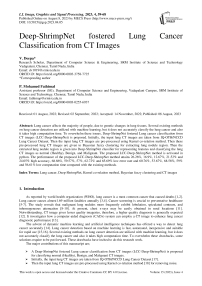Deep-ShrimpNet fostered Lung Cancer Classification from CT Images
Автор: V. Deepa, Mohamed Fathimal P.
Журнал: International Journal of Image, Graphics and Signal Processing @ijigsp
Статья в выпуске: 4 vol.15, 2023 года.
Бесплатный доступ
Lung cancer affects the majority of people, due to genetic changes in lung tissues. Several existing methods on lung cancer detection are utilized with machine learning, but it does not accurately classify the lung cancer and also it takes high computation time. To overwhelm these issues, Deep-ShrimpNet fostered Lung cancer classification from CT images (LCC-Deep-ShrimpNet) is proposed. Initially, the input lung CT images are taken from IQ-OTH/NCCD Lung Cancer Dataset. Then the input lung CT images are pre-processed using Kernel co-relation method. Then these pre-processed lung CT images are given to Bayesian fuzzy clustering for extracting lung nodule region. Then the extracted lung nodule region is given into Deep-ShrimpNet classifier for representing features and classifying the lung CT images as normal (Healthy), Benign, and Malignant. The proposed LCC-Deep-ShrimpNet method is activated in python. The performance of the proposed LCC-Deep-ShrimpNet method attains 26.26%, 16.9%, 12.67%, 21.52% and 24.05% high accuracy, 68.86%, 59.57%, 57%, 62.72% and 65.69% low error rate and 60.76%, 53.67%, 68.58%, 59% and 56.61% low computation time compared with the existing methods.
Lung cancer, Deep-ShrimpNet, Kernel co-relation method, Bayesian fuzzy clustering and CT images
Короткий адрес: https://sciup.org/15018771
IDR: 15018771 | DOI: 10.5815/ijigsp.2023.04.05
Список литературы Deep-ShrimpNet fostered Lung Cancer Classification from CT Images
- X. Yang, J. Man, H. Chen, T. Zhang, X. Yin, Q. He, and M. Lu. ‘Temporal trends of the lung cancer mortality attributable to smoking from 1990 to 2017: a global, regional and national analysis’. Lung cancer. 2021, vol.152: pp. 49-57.
- R. Bhakta, and A.A. Hossain. ‘Lung tumor segmentation and staging from ct images using fast and robust fuzzy C-Means clustering’. International Journal of Image, Graphics and Signal Processing. 2020, vol.11, no.1: pp.38.
- K. Rashmi, and K. Bhavani. ‘Analysis of CT DICOM image segmentation for abnormality detection’. International Journal of Engineering and Manufacturing. 2019, vol. 9, no.5: pp.46-55.
- O.M. Elzeki, M.F. Alrahmawy, and S. Elmougy. ‘A new hybrid genetic and information gain algorithm for imputing missing values in cancer genes datasets’. International Journal of Intelligent Systems and Applications. 2019, vol.11, no.12:pp.20.
- K .Xu, C. Zhang, T .Du, A.N. Gabriel, X. Wang, X .Li, L. Sun, N .Wang, X. Jiang, and Y .Zhang. ‘Progress of exosomes in the diagnosis and treatment of lung cancer’. Biomedicine & Pharmacotherapy. 2021;134:111111.
- A .Khanmohammadi, A. Aghaie, E .Vahedi, A. Qazvini, M. Ghanei, A .Afkhami, A. Hajian, and H. Bagheri. ‘Electrochemical biosensors for the detection of lung cancer biomarkers: A review’. Talanta. 2020;vol.206:pp120251.
- J. Luo, H. Rizvi, I.R. Preeshagul, J.V. Egger, D. Hoyos, C .Bandlamudi, C.G. McCarthy, C.J. Falcon, A.J. Schoenfeld, K.C. Arbour, and J.E. Chaft. ‘COVID-19 in patients with lung cancer’. Annals of Oncology. 2020;vol.31,no.10:pp1386-96.
- M .Norouzi, P. Hardy. ‘Clinical applications of nanomedicines in lung cancer treatment’. Acta Biomaterialia. 2021;vol.121:134-42.
- H .Hu, Z. Piotrowska, P.J. Hare, H. Chen, H.E. Mulvey, A. Mayfield, S .Noeen, K.Kattermann, M. Greenberg, A. Williams, and A.K. Riley. ‘Three subtypes of lung cancer fibroblasts define distinct therapeutic paradigms’. Cancer Cell. 2021;vol.39,no.11:pp1531-47.
- S. Xie, Z. Wu, Y. Qi, B. Wu, and X. Zhu. ‘The metastasizing mechanisms of lung cancer: recent advances and therapeutic challenges’. Biomedicine & Pharmacotherapy. 2021;138:pp111450.
- D.M. Ibrahim, N.M. Elshennawy, and A.M. Sarhan. ‘Deep-chest: Multi-classification deep learning model for diagnosing COVID-19, pneumonia, and lung cancer chest diseases’. Computers in biology and medicine. 2021;vol.132:pp104348.
- S. Rezaei, M. Mahjoubin-Tehran, S.H. Aghaee-Bakhtiari, A .Jalili, A .Movahedpour, H .Khan, M .Moghoofei, Z. Shojaei, M.R. Hamblin, and H. Mirzaei. ‘Autophagy-related MicroRNAs in chronic lung diseases and lung cancer’. Critical reviews in oncology/hematology. 2020;vol.153:pp103063.
- B.Y. Wang, J.Y. Huang, H.C. Chen, C.H. Lin, S.H. Lin, W.H. Hung, and Y.F. Cheng. ‘The comparison between adenocarcinoma and squamous cell carcinoma in lung cancer patients’. Journal of cancer research and clinical oncology. 2020;vol.146,no.1:pp43-52.
- S.K. Thakur, D.P. Singh, and J. Choudhary . ‘Lung cancer identification: a review on detection and classification’. Cancer and Metastasis Reviews. 2020;39,no.3:pp989-98.
- S .Mishra, H.K. Thakkar, P.K. Mallick, P. Tiwari, and A. Alamri. ‘A sustainable IoHT based computationally intelligent healthcare monitoring system for lung cancer risk detection’. Sustainable Cities and Society. 2021 ,vol.72:pp103079.
- K .Pradhan, and P. Chawla. ‘Medical Internet of things using machine learning algorithms for lung cancer detection’. Journal of Management Analytics. 2020;vol.7,no.4:pp591-623.
- https://www.google.com/url?q=https://www.kaggle.com/datasets/adityamahimkar/iqothnccd-lung-cancer-dataset&sa=D&source=hangouts&ust=1656405287675000&usg=AOvVaw2W71zj3mJwwNjrtzd86ODI
- C. Liu, J .Gong, J .Zhu, J. Zhang, and Y .Yan. ‘Correlation filter with motion detection for robust tracking of shape-deformed targets’. Ieee Access. 2020;vol.8:pp89161-70.
- V. Sreeparvathy, and V.V. Srinivas. ‘A Bayesian Fuzzy Clustering Approach for Design of Precipitation Gauge Network Using Merged Remote Sensing and Ground‐Based Precipitation Products’. Water Resources Research. 2022;vol.58,no.2:e2021WR030612.
- Liu Z. ‘Soft-shell shrimp recognition based on an improved AlexNet for quality evaluations’. Journal of Food Engineering. 2020 ,vol.266:pp.109698.
- P.M. Shakeel, M.A. Burhanuddin, and M.I. Desa. ‘Automatic lung cancer detection from CT image using improved deep neural network and ensemble classifier’. Neural Computing and Applications. 2020:pp.1-4.
- W.J. Sori, J. Feng, A.W. Godana, S. Liu, and D.J. Gelmecha. ‘DFD-Net: lung cancer detection from denoised CT scan image using deep learning’. Frontiers of Computer Science. 2021;vol.15,no.2:pp.1-3.
- A. Asuntha, and A. Srinivasan. ‘Deep learning for lung Cancer detection and classification. Multimedia Tools and Applications’. 2020;vol.79,no.11,pp7731-62.
- H. Yu, Z. Zhou, and Q. Wang. ‘Deep learning assisted predict of lung cancer on computed tomography images using the adaptive hierarchical heuristic mathematical model’. IEEE Access. 2020;vol.8,pp.86400-10.
- M.A. Heuvelmans, P.M. van Ooijen, S. Ather, C.F. Silva, D. Han, C.P. Heussel, W. Hickes, H.U. Kauczor, P. Novotny, H. Peschl, and M .Rook. ‘Lung cancer prediction by Deep Learning to identify benign lung nodules’. Lung Cancer. 2021;vol.154:pp1-4.
- S. Shanthi, and N .Rajkumar. ‘Lung cancer prediction using stochastic diffusion search (SDS) based feature selection and machine learning methods’. Neural Processing Letters. 2021;vol.53,no.(4):pp.2617-30.


